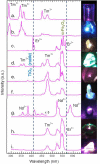Shifting the Sun: Solar Spectral Conversion and Extrinsic Sensitization in Natural and Artificial Photosynthesis
- PMID: 27774377
- PMCID: PMC5063168
- DOI: 10.1002/advs.201500218
Shifting the Sun: Solar Spectral Conversion and Extrinsic Sensitization in Natural and Artificial Photosynthesis
Abstract
Solar energy harvesting is largely limited by the spectral sensitivity of the employed energy conversion system, where usually large parts of the solar spectrum do not contribute to the harvesting scheme, and where, of the contributing fraction, the full potential of each photon is not efficiently used in the generation of electrical or chemical energy. Extrinsic sensitization through photoluminescent spectral conversion has been proposed as a route to at least partially overcome this problem. Here, we discuss this approach in the emerging context of photochemical energy harvesting and storage through natural or artificial photosynthesis. Clearly contrary to application in photovoltaic energy conversion, implementation of solar spectral conversion for extrinsic sensitization of a photosynthetic machinery is very straightforward, and-when compared to intrinsic sensitization-less-strict limitations with regard to quantum coherence are seen. We now argue the ways in which extrinsic sensitization through photoluminescent spectral converters will-and will not-play its role in the area of ultra-efficient photosynthesis, and also illustrate how such extrinsic sensitization requires dedicated selection of specific conversion schemes and design strategies on system scale.
Keywords: artificial photosynthesis; photosynthesis; solar spectral conversion; solar‐to‐fuel; water splitting.
Figures






Similar articles
-
Solar fuels via artificial photosynthesis.Acc Chem Res. 2009 Dec 21;42(12):1890-8. doi: 10.1021/ar900209b. Acc Chem Res. 2009. PMID: 19902921
-
Artificial Photosynthesis at Efficiencies Greatly Exceeding That of Natural Photosynthesis.Acc Chem Res. 2019 Nov 19;52(11):3143-3148. doi: 10.1021/acs.accounts.9b00380. Epub 2019 Oct 8. Acc Chem Res. 2019. PMID: 31593438 Review.
-
Biomimetic and microbial approaches to solar fuel generation.Acc Chem Res. 2009 Dec 21;42(12):1899-909. doi: 10.1021/ar900127h. Acc Chem Res. 2009. PMID: 19757805
-
Strategies for Efficient Charge Separation and Transfer in Artificial Photosynthesis of Solar Fuels.ChemSusChem. 2017 Nov 23;10(22):4277-4305. doi: 10.1002/cssc.201701598. Epub 2017 Nov 14. ChemSusChem. 2017. PMID: 29105988 Review.
-
Energy conversion in natural and artificial photosynthesis.Chem Biol. 2010 May 28;17(5):434-47. doi: 10.1016/j.chembiol.2010.05.005. Chem Biol. 2010. PMID: 20534342 Free PMC article. Review.
Cited by
-
Spectral-conversion film potential for greenhouses: Utility of green-to-red photons conversion and far-red filtration for plant growth.PLoS One. 2023 Feb 23;18(2):e0281996. doi: 10.1371/journal.pone.0281996. eCollection 2023. PLoS One. 2023. PMID: 36821557 Free PMC article.
-
Light extraction from fundamental modes in modulated waveguides for homogeneous side-emission.Sci Rep. 2018 Jun 22;8(1):9527. doi: 10.1038/s41598-018-27916-x. Sci Rep. 2018. PMID: 29934607 Free PMC article.
-
Intracellular spectral recompositioning of light enhances algal photosynthetic efficiency.Sci Adv. 2017 Sep 1;3(9):e1603096. doi: 10.1126/sciadv.1603096. eCollection 2017 Sep. Sci Adv. 2017. PMID: 28879232 Free PMC article.
-
Study of Optical Configurations for Multiple Enhancement of Microalgal Biomass Production.Sci Rep. 2019 Feb 11;9(1):1723. doi: 10.1038/s41598-018-38118-w. Sci Rep. 2019. PMID: 30742048 Free PMC article.
-
Multi-bandgap Solar Energy Conversion via Combination of Microalgal Photosynthesis and Spectrally Selective Photovoltaic Cell.Sci Rep. 2019 Dec 12;9(1):18999. doi: 10.1038/s41598-019-55358-6. Sci Rep. 2019. PMID: 31831795 Free PMC article.
References
-
- Shockley W., Queisser H. J., J. Appl. Phys. 1961, 32, 510.
-
- Razykov T. M., Ferekides C. S., Morel D., Stefanakos E., Ullal H. S., Upadhyaya H. M., Sol. Energ. 2011, 85, 1580.
-
- Strümpel C., McCann M., Beaucarne G., Arkhipov V., Slaoui A., Vrcˇek V., Cañizo C., Tobias I., Sol. Energ. Mater. Sol. Cells 2007, 91, 238.
-
- Huang X., Han S., Huang W., Liu X., Chem. Soc. Rev. 2013, 42, 173. - PubMed
-
- Goldschmidt J. C., Fischer S., Adv. Opt. Mater. 2015, 3, 510.
LinkOut - more resources
Full Text Sources
Other Literature Sources
